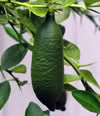Pagnr,
From the info in this article they are not the same.
I down loaded it from a UCR site but the site isn't there anymore.
The Sun-Chu-Sha-Kat is an ancient Chinese cultivar. It was probably first described in any detail by Han-yen-Chih on page 21 of the English translation of his monograph called the Chu Lu published in 1178 A.D. Han-yen-Chih doesnt provide much information about the cultivar except to say it is a small fruit with a very delicious taste and tender flesh (actually, the fruit is quite tart, much like Sunki, Shekwasha, Cleopatra, and other small acid mandarins). Han-yen-Chih states that the color of the rind is a deep red and that the tree grows well on sandy soilswhich Hutchinson found out in Florida. This cultivar is not only common in China, but also in Japan and Assam. T. Tanaka in his Species Problems in Citrus published in 1954 refers to this variety as the Kobeni-mikan (beni in Japanese meaning red) and he taxonomically refers to it as Citrus erythrosa (erythro meaning red, as in erythrocyte, a red blood cell). The cultivar is taxonomically placed in T. Tanakas Acrumen-Microacrumen-Citidora-Microcarpa-Angrestifolia grouping. Such a designation to many readers is confusing and difficult to remember, but more simply it would be in W.T. Swingles (1948) citrus classification scheme as Citrus reticulate var. austere; along with many other non-commerical, small-fruited, generally acid, seedy mandarins like, Cleopatra, Sunki, Shekwarhe, Kinokuni, Girimikan, and others.
One of the key identification characters of the Sun-Chu-Sha-Kat is the very bright reddish-orange color of the rind. But some confusion developed in the Philippines when another cultivar with the same characteristics and displaying some rootstock promise, was distinguished by still another synonym, the Calamandarin. Some would be taxonomists blithely predicted it was probably a hybrid between the calamondin (C. madurensisand in the Phippine called the calamonding) and a mandarin. But such was not the caseand hencethe rest of the story.
The confusion regarding the cultivar arose during World War II and the subsequent occupation of the Philippinis by the Japanese military. All records and most of the trees existing then in the Philippine citrus variety collection at the Lipa Experiment Station were destroyed by the Japanese. About 1953, Mr. P.A. Rodrigo, an administrator with the Bureau of Plant Industry in Manila, P.I., visited the University of California Citrus Experiment Station at Riverside, California. In a discussion of the senior author with Mr. Rodrigo, the senior author was informed that the Bureau of Plant Industry was testing a new citrus cultivar as a rootstock in the Philippines. He called the cultivar the Calamandarin, but could not supply any additional information on its identity. Mr. Rodrigo kindly supplied the Citrus Experiment Station at Riverside in 1954 and several selected seedlings became the C.E.S. accession number 3073. No references to the cultivar.
The confusion in the Philippines was that Tanaka had given the name of Citrus erythrosa to the Sun-Chu-Sha-Katthe vernacular (common) name was Kobeni-mikan. The Cleopatra mandarinTanakas Citrus reshni was somewhat similar in appearance, and the vernacular name was obeni-mikan. If you didnt know Japaneseyou could get into trouble!
The Sun-Chu-Sha-Kat resistance to Tristeza as a rootstock was tested at the Irvine South Coast Field Station. The inoculated trees showed no reaction to Tristeza. A rootstock planting for the Lindcove Field Station included the Sun-Chu-Sha-Kat. The young trees on that rootstock were inoculated with nematodes to determine its tolerance to the citrus nematode. This information is not available.













